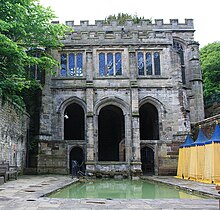
Back Fuente de Santa Winifrida Spanish Sanctuaire Sainte-Winefride de Holywell French באר ויניפרד הקדושה HE Fonte di santa Winfreda Italian Fonte de Santa Vinifrida Portuguese St Winefride's Well Swedish
| St Winefride's Well | |
|---|---|
 | |
| Religion | |
| Affiliation | Roman Catholicism |
| Patron | Saint Winefride |
| Status | Active |
| Location | |
| Location | Holywell, Flintshire |
| Country | Wales |
| Architecture | |
| Style | Perpendicular Gothic |
| Completed | c. 1512–1525 |
| Materials | Sandstone |
| Website | |
| www | |
St Winefride's Well (Welsh: Ffynnon Wenffrewi) is a holy well and national shrine located in the Welsh town of Holywell in Flintshire. The patron saint of the well, St Winefride, was a 7th-century Catholic martyr who according to legend was decapitated by a lustful prince and then miraculously restored to life. The well is said to have sprung up at the spot where her head hit the ground. This story is first recorded in the 12th century, and since then St Winefride's Well has been a popular pilgrimage destination, known for its healing waters. The well is unique among Britain's sacred sites in that it retained a continuous pilgrimage tradition throughout the English Reformation.
During the Middle Ages, the well formed part of the estate of nearby Basingwerk Abbey. It was visited by several English monarchs, including Richard II and Henry IV. Following the establishment of the Church of England, attempts were made by the Protestant authorities to prevent Catholic pilgrimage to the well, but these attempts were unsuccessful. From the 18th century onwards, the well increasingly attracted secular tourism, and it was commonly believed that the well-water had natural healing properties by virtue of its mineral content. Two bath-houses were built on the site in 1869. In 1917, the well dried up as a result of mining operations in the Greenfield valley; to get it flowing again, water had to be diverted from a new underground source.
The chapel above the well was built in the 16th century. It is a grade I listed building and a scheduled ancient monument. It comprises two parts, the upper chapel and the well crypt. The upper chapel has seen a variety of uses, including service as a sessions house and a secular day school, but is presently used for religious worship. The well crypt contains a star-shaped basin that encloses the well-spring, and an 18th-century statue of St Winefride. Both sections of the chapel are under state guardianship and managed by Cadw.
The well complex is currently open to visitors, who may bathe in the water at certain times of day or fill water bottles from an outdoor tap. There is a visitors' centre and museum on the site. Organised group pilgrimages take place several times a year, and during the pilgrimage season, St Winefride's relic is venerated daily in the well crypt.
© MMXXIII Rich X Search. We shall prevail. All rights reserved. Rich X Search